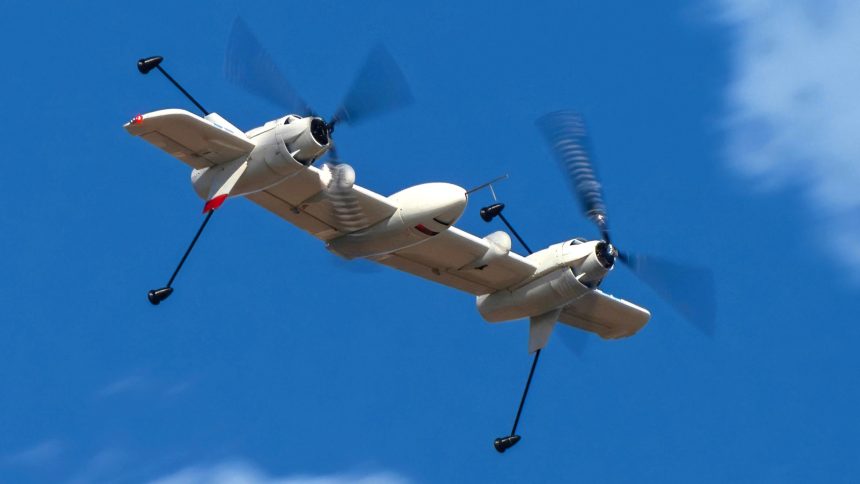The aircraft is meant to develop and mature rotor blown wing design, which can now be applied to larger aircraft for unmanned aerial logistics and even tactical ISR missions.
Sikorsky announced it has flown the prototype of its unique VTOL (Vertical Take-Off Landing) UAS (Uncrewed Aerial System) based on the Rotor Blown Wing technology. By flying in both the helicopter and airplane flight modes, the company validated the advanced control laws used to fly the unmanned aircraft.
The aircraft, whose name has not been disclosed, takes off vertically like a helicopter and then tilts the entire airframe to put the wings level and fly like an aircraft. The company showed in a video that this would be useful in operating from see-sawing ship decks and unprepared ground to meet logistical, cargo, surveillance and humanitarian missions needs.
The UAS was developed by Sikorsky Innovations, the company’s rapid prototyping group, which progressed through preliminary design, simulation, tethered and untethered flight to gather aerodynamic, flight control and quality data, in just over a year, according to the press release. In fact, this design is among the proposals that were selected last year by the Defense Advanced Research Projects Agency (DARPA) for the AdvaNced airCraft Infrastructure-Less Launch And RecoverY (ANCILLARY) program.
The company says a breakthrough was achieved in Jan. 2025, when the electrically powered twin prop-rotor prototype with a 10.3 ft composite wingspan “successfully completed more than 40 take-offs and landings.” During these flights, the prototype also “performed 30 transitions between helicopter and airplane modes, the most complex maneuver demanded of the design.”
The aircraft is meant to study the design’s handling, control laws and aerodynamic performance, which can now be applied to larger aircraft for unmanned aerial logistics and even tactical ISR missions, as seen in the renditions. Other roles mentioned by Sikorsky include SAR (Search and Rescue), firefighting monitoring, pipeline surveilling, long-range ISR and crewed-uncrewed teaming missions.
Sikorsky’s MATRIX autonomous flight software
The firm adds that the rotor blown wing design is one of a future family of systems it is developing, all of which would include winged VTOL UAS and single main rotor aircraft, governed by Sikorsky’s MATRIX flight autonomy system. MATRIX is the technological foundation for DARPA’s ALIAS (Aircrew Labor In-cockpit Automation System) program that Sikorsky has developed since 2020.
As The Aviationist reported, the software powers a UH-60A Optionally Piloted Black Hawk which performed a first-of-its-kind 30 minute fully autonomous flight, without anyone onboard, at Fort Campbell, Kentucky, on Feb. 5, 2022, followed by a second flight on Feb. 7. Previous tests in 2021 demonstrated complete supervised autonomy, including autonomous take-off, landing and two simulated obstacle avoidance scenarios, all supervised using only a tablet.
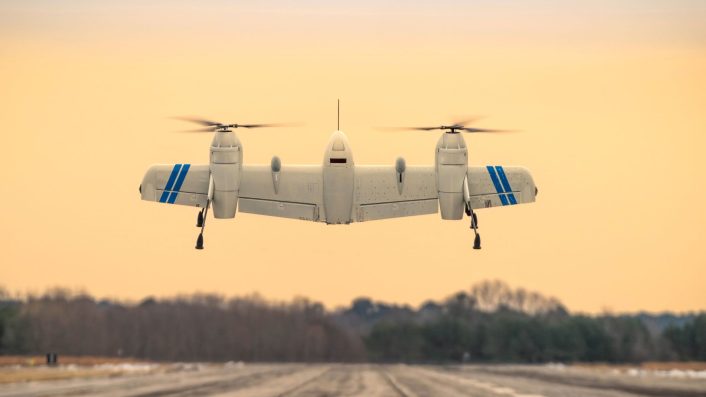
Two other developments took place in Oct. 2024, as DARPA (Defense Advanced Research Projects Agency) previously contracted Sikorsky to equip the U.S. Army’s experimental fly-by-wire UH-60 Black Hawk helicopter with its MATRIX. On Oct. 17, the company demonstrated the technology at the AUSA (Association of the United States Army) symposium in Washington D.C. by remotely controlling a UH-60 Black Hawk from 300 miles away.
The Rotor Blown Wing UAS
The Rotor Blown Wing drone has two engines, mounted near the tips of a ‘straight leading edge-tapered trailing edge’-type wing, turning three-bladed propellers. In the center of the wing there is a fuselage with a shape similar to the one of the engine nacelles.
The drone lands vertically, with the straight leading edge – and thereby the propellers and the engines – facing upwards. It is supported by two outward-facing arms on each side of the wings beside the engines, with simple supports instead of wheels .
The prototype UAS, as shown in the video, is not longer than a standard city motorcycle, with its larger-scale versions, seen in the renditions, being almost the size of a regular four-seater family hatchback.
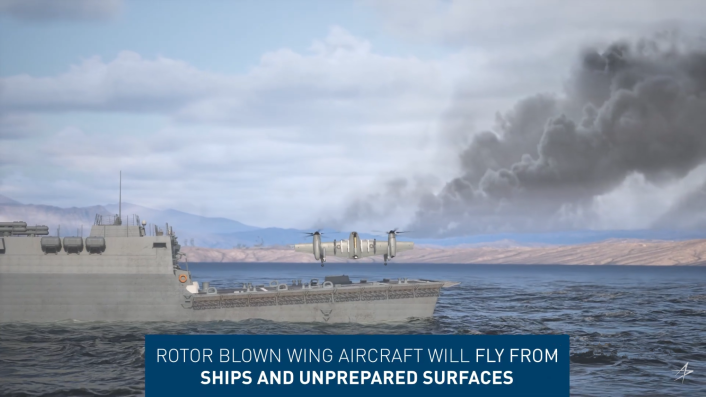
After taking off vertically, the entire aircraft tilts forward to “cruise like an airplane.” This is unlike the other VTOL drones being tested by the U.S. Navy, or personal transport electric VTOL (eVTOL) aircraft being tried by the U.S. Air Force and even operational aircraft like the V-22 Osprey, where only the engines tilt forward to transition to fixed-wing forward flight.
Testing, performance and control
The video said a major aerodynamic challenge was transitioning the aircraft from helicopter to wing-borne flight, requiring new control laws for the maneuver. The downwash from the rotors blows over the wing to increase lift once the transition to airplane mode is complete.
The aircraft does not have any vertical stabilizers, acting as a flying wing once in airplane mode. The “flight control in all regimes was seamless,” says Sikorsky.
Sikorsky Innovations’s director Igor Cherepisnky said in the company’s statement that the rotor blown wing “demonstrated the control power and unique handling qualities necessary to transition repeatedly and predictably from a hover to high-speed wing-borne cruise flight, and back again.” He further added that “new control laws were required for this transition maneuver,” and “the data indicates we can operate from pitching ships decks and unprepared ground when scaled to much larger sizes.”

In addition to the 30 transitions between helicopter and airplane modes, the statement from the company added more details about the testing, mentioning that “in horizontal flight mode, the aircraft reached a top cruise speed of 86 knots.” Also, “simultaneous wind tunnel tests were conducted on a 1:1 scale model providing valuable validation of the newly developed control laws by correlating them with real-world experimental data.”

Sikorsky Vice President and General Manager Rich Benton, describing the effort behind the new system, said that “combining helicopter and airplane flight characteristics onto a flying wing reflects Sikorsky’s drive to innovate next-generation VTOL UAS aircraft that can fly faster and farther than traditional helicopters.”
ANCILLARY
In May 2024, DARPA announced the selection of the designs which would continue working on the development of the AdvaNced airCraft Infrastructure-Less Launch And RecoverY (ANCILLARY) program. The program aims to develop and flight demonstrate the critical technologies required for a leap-ahead in long endurance, vertical takeoff and landing (VTOL) unmanned air system (UAS) performance while operating from a moving ship at sea.
The UAS is intended to be able to launch and recover from ship flight decks and small austere land locations in adverse weather without additional infrastructure equipment, thus enabling expeditionary deployments. Unlike large VTOL systems, the small UAS size would allow many aircraft to be stored and operated from one ship creating a tactical beyond-line-of-site (BLOS) multi-intelligence sensor network capability.
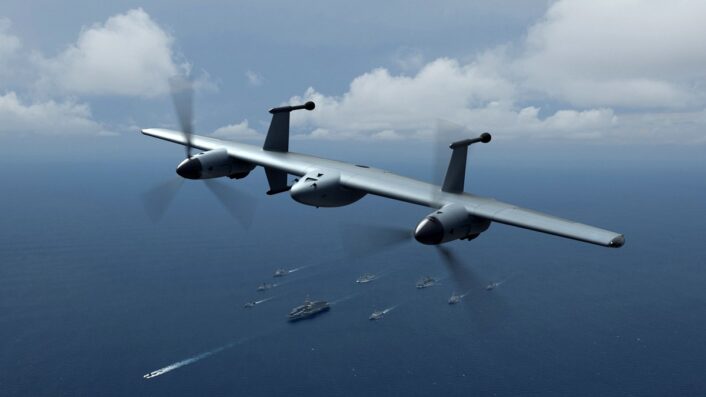
DARPA initially selected nine companies in 2023, reducing them to six in 2024. Among these is Sikorsky which, as part of Phase Ib, will mature its X-plane design, with concentration on reducing system risks through refined higher fidelity design and analysis and by conducting component and configuration hover testing. At the end of this 10-month phase, the six teams will submit competitive proposals for Phase II detailed design, fabrication, and flight testing.
These technologies will support a future operational UAS that can be deployed and retrieved from Navy ships without the large mechanical launchers and landing/recovery equipment used today, taking off like a helicopter and flying missions like a very efficient winged aircraft while carrying significant payload when needed. The novel UAS will have multiple roles, ranging from Intelligence, Surveillance and Reconnaissance (ISR) to logistics and even strike missions.
Tactical use
Tilt-rotor and engine pivoting might require complex engineering. Software or algorithms dictating power and weight distribution while landing on uneven surfaces or heavily pitching helicopter decks on warships in bad sea states is a much easier proposition.
Moreover, the autonomous flight function capability described for the Rotor Blown Wing UAS, is also suited for its stated roles in routine tactical logistics, ISR and HADR, requiring little complex and contextual decision-making, otherwise needed for combat missions. These require evading enemy detection and engaging targets while also focusing on flying functions.
The renditions show a small EO (Electro-Optical) ball turret in the nose for ISR roles, clearly a capability meant for the full-sized demonstrators, or pre-production prototypes. Also, the UAS is shown armed, with a total of seven hardpoints.
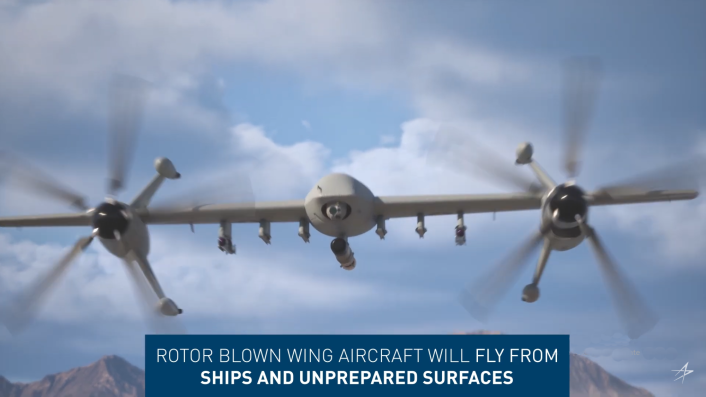
In another computer generated clip, the UAS is seen landing vertically, exposing the seven hardpoints. Production variants could be powered by even more powerful engines with a wider ordnance payload, giving diverse surveillance-strike options.
It can be assumed that the MATRIX software is already capable of set waypoint navigation between supply nodes and forward areas, ferrying everything from ordnance, rations, medical supplies and relief materials, and a possible man-in-the-loop option with the ground crew operating the control station and monitoring the flight.
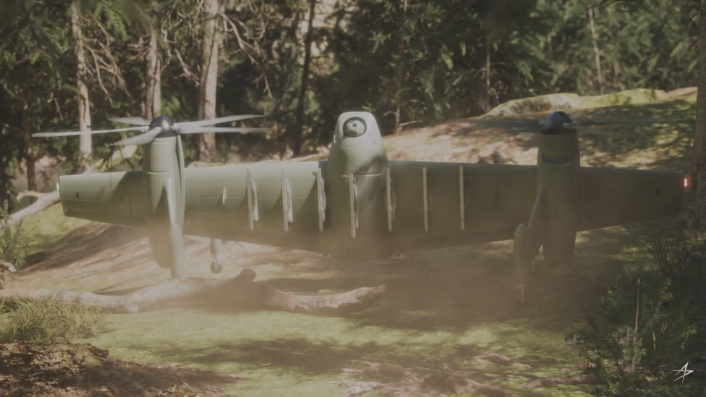
The ability to overcome the limitations imposed by human endurance would be tremendous in the high-intensity, high-end war that might erupt in the Pacific, continuously feeding troops with critical supplies and unburdening the outsized and costlier manned platforms for the more important missions. Needless to say, the system would be a boon for the Air Force’s ACE (Agile Combat Employment) effort across the European and Indo-Pacific Theaters, transporting critical spares to austere air fields.

